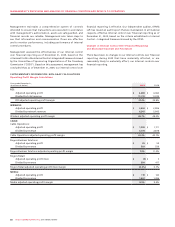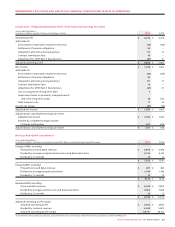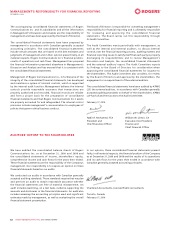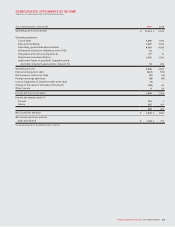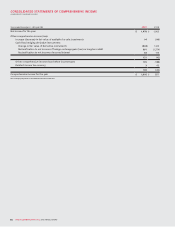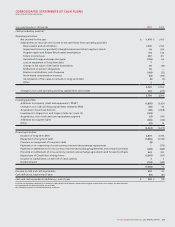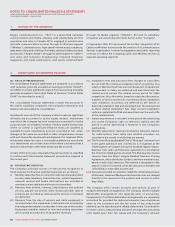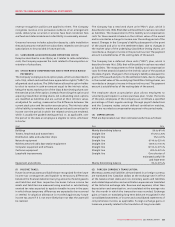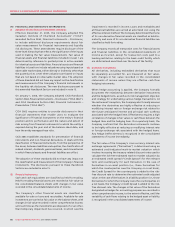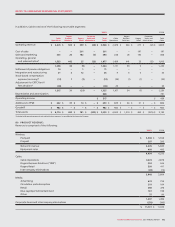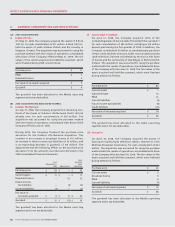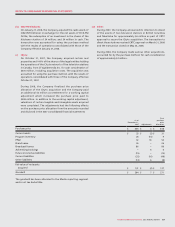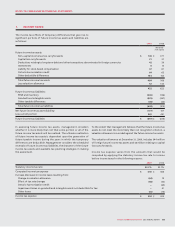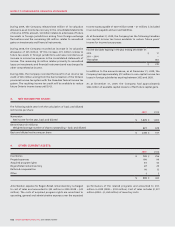Rogers 2009 Annual Report Download - page 86
Download and view the complete annual report
Please find page 86 of the 2009 Rogers annual report below. You can navigate through the pages in the report by either clicking on the pages listed below, or by using the keyword search tool below to find specific information within the annual report.
90 ROGERS COMMUNICATIONS INC. 2009 ANNUAL REPORT
NOTES TO CONSOLIDATED FINANCIAL STATEMENTS
(H) FINANCIAL AND DERIVATIVE INSTRUMENTS:
(i) Adoption of new financial instruments standards:
Effective December 31, 2009, the Company adopted The
Canadian Institute of Chartered Accountants’ (“CICA”)
amended Section 3862, Financial Instruments – Disclosures,
to include additional disclosure requirements about fair
value measurement for financial instruments and liquidity
risk disclosures. These amendments require disclosure of the
three-level hierarchy that reflects the significance of the inputs
used in making the fair value measurements. Fair value of
financial assets and financial liabilities included in Level 1 are
determined by reference to quoted prices in active markets
for identical assets and liabilities. Financial assets and financial
liabilities in Level two include valuations using inputs based on
observable market data, either directly or indirectly other than
the quoted prices. Level three valuations are based on inputs
that are not based on observable market data. The adoption
of these standards did not have any impact on the classification
and measurement of the Company’s financial instruments or
the liquidity risk disclosures. The new disclosures pursuant to
this amended Handbook Section are included in note 15.
On January 1, 2008, the Company adopted CICA Handbook
Section 3862, Financial Instruments – Disclosures (“CICA 3862”),
and CICA Handbook Section 3863, Financial Instruments –
Presentation (“CICA 3863”).
CICA 3862 requires entities to provide disclosures in their
financial statements that enable users to evaluate the
significance of financial instruments on the entity’s financial
position and its performance and the nature and extent of
risks arising from financial instruments to which the entity is
exposed during the year and at the balance sheet date, and
how the entity manages those risks.
CICA 3863 establishes standards for presentation of financial
instruments and non-financial derivatives. It deals with the
classification of financial instruments, from the perspective of
the issuer, between liabilities and equities, the classification of
related interest, dividends, gains and losses, and circumstances
in which financial assets and financial liabilities are offset.
The adoption of these standards did not have any impact on
the classification and measurement of the Company’s financial
instruments. The disclosures pursuant to these Handbook
Sections are included in note 15.
(ii) Financial instruments:
Cash and cash equivalents are classified as held-for-trading.
Held-for-trading financial assets are recorded at fair value on
the consolidated balance sheets with changes in fair value
recorded in the consolidated statements of income.
The Company’s other financial assets are classified as
available-for-sale or loans and receivables. Available-for-sale
investments are carried at fair value on the balance sheet, with
changes in fair value recorded in other comprehensive income,
until such time as the investments are disposed of or an other-
than-temporary impairment has occurred, in which case the
impairment is recorded in income. Loans and receivables and
all financial liabilities are carried at amortized cost using the
effective interest method. The Company determined that none
of its non-derivative financial assets are classified as held-to-
maturity and none of its non-derivative financial liabilities are
classified as held-for-trading.
The Company records all transaction costs for financial assets
and financial liabilities in the consolidated statements of
income as incurred, except for transaction costs paid to a
lending institution relating to the bank credit facility which
are deferred and amortized over the term of the facility.
(iii) Derivative instruments:
All derivatives, including embedded derivatives that must
be separately accounted for, are measured at fair value,
with changes in fair value recorded in the consolidated
statements of income unless they are effective cash flow
hedging instruments.
When hedge accounting is applied, the Company formally
documents the relationship between derivative instruments
and the hedged items, as well as its risk management objective
and strategy for undertaking various hedge transactions. At
the instrument’s inception, the Company also formally assesses
whether the derivatives are highly effective at reducing or
modifying interest rate or foreign exchange risk related to
the future anticipated interest and principal cash outflows
associated with the hedged item. Effectiveness requires a high
correlation of changes in fair values or cash flows between the
hedged item and the hedging item. On a quarterly basis, the
Company confirms that the derivative instruments continue
to be highly effective at reducing or modifying interest rate
or foreign exchange risk associated with the hedged items.
Any hedge ineffectiveness is recognized in the consolidated
statements of income immediately.
The fair value of the Company’s cross-currency interest rate
exchange agreements (“Derivatives”) is determined using an
estimated credit-adjusted mark-to-market valuation which
involves increasing the treasury-related discount rates used to
calculate the risk-free estimated mark-to-market valuation by
an estimated credit spread (“Credit Spread”) for the relevant
term and counterparty for each Derivative. In the case of
Derivatives in an asset position (i.e., those Derivatives for
which the counterparties owe the Company on a net basis),
the Credit Spread for the counterparty is added to the risk-
free discount rate to determine the estimated credit-adjusted
value. In the case of Derivatives in a liability position (i.e., those
Derivatives for which the Company owes the counterparties on
a net basis), the Company’s Credit Spread is added to the risk-
free discount rate. The changes in fair value of the Derivatives
designated as hedges for accounting purposes are recorded in
other comprehensive income, to the extent effective, until the
variability of cash flows relating to the hedged asset or liability
is recognized in the consolidated statements of income.


